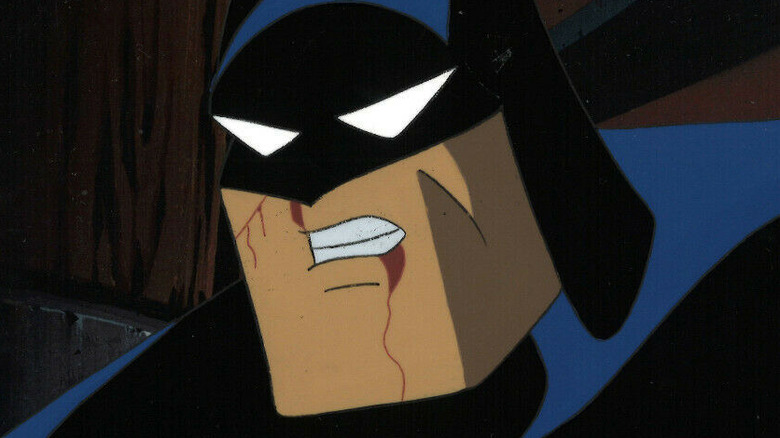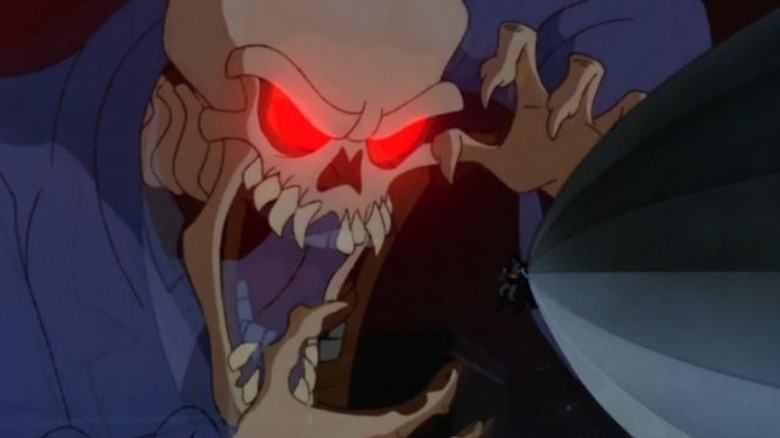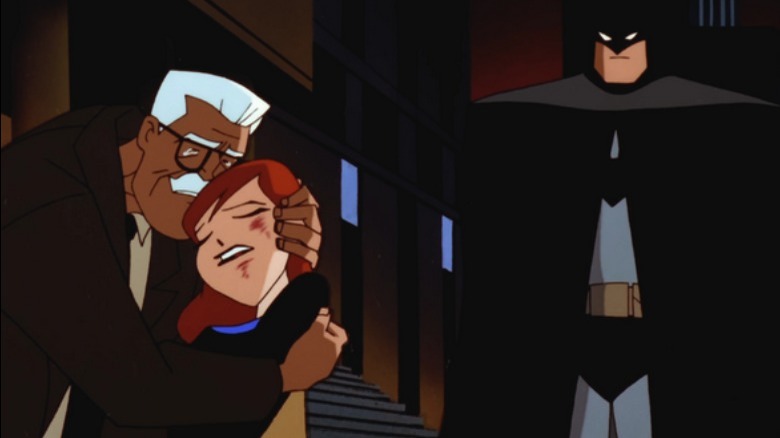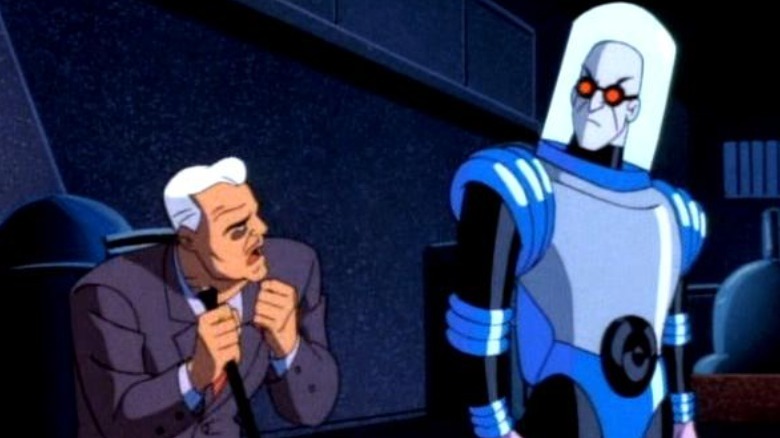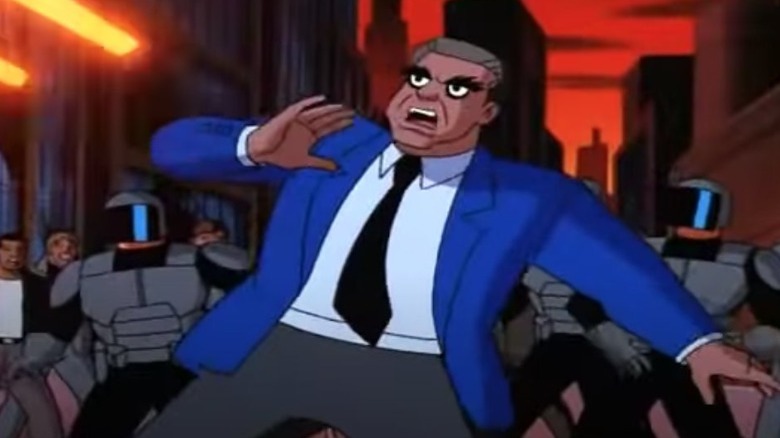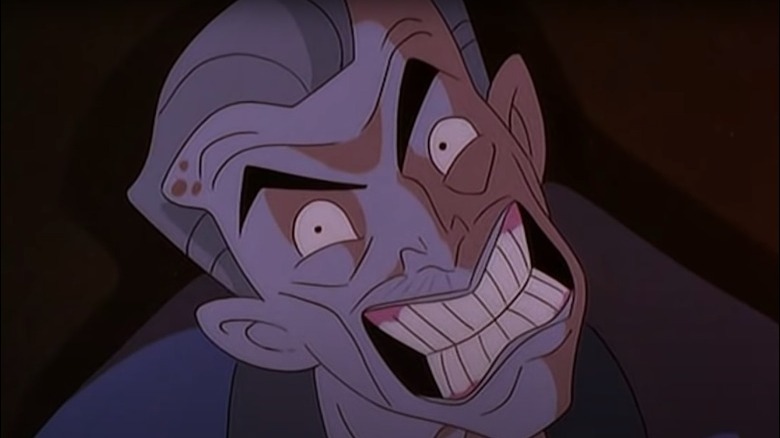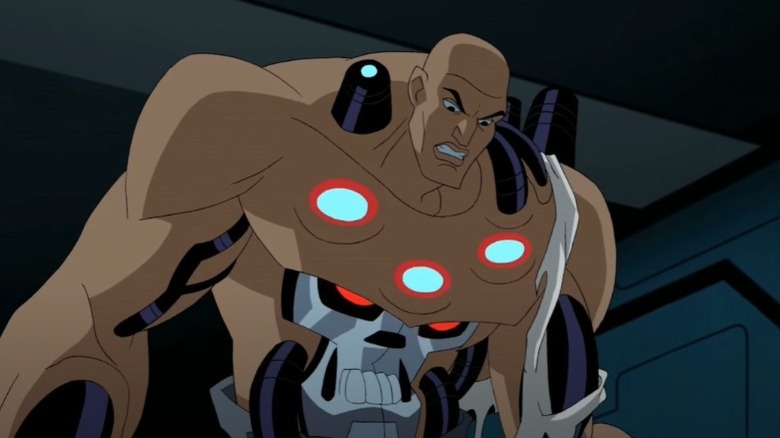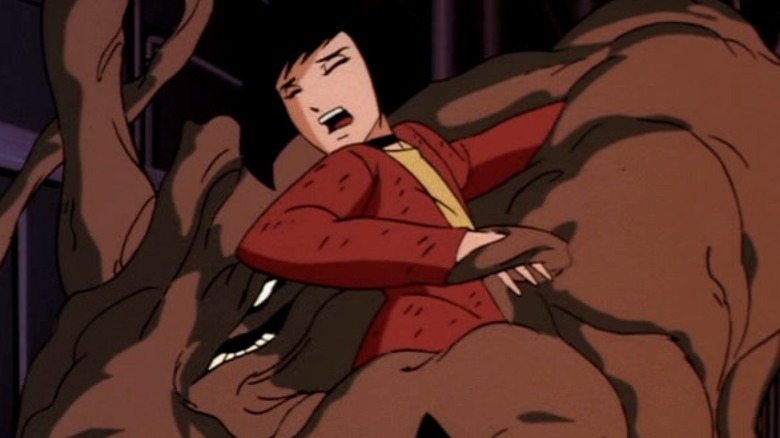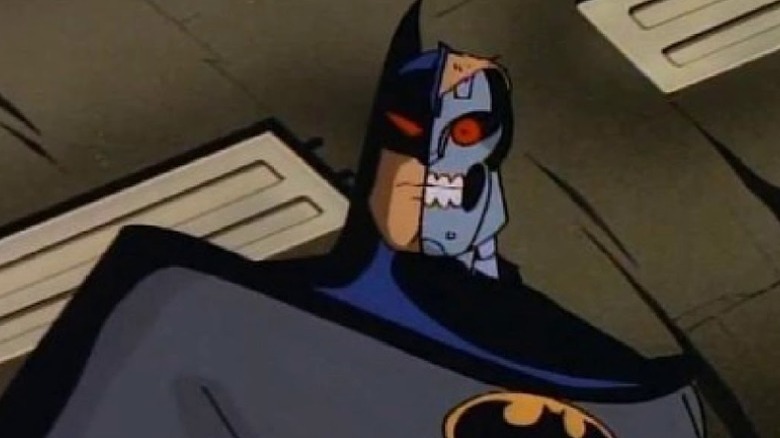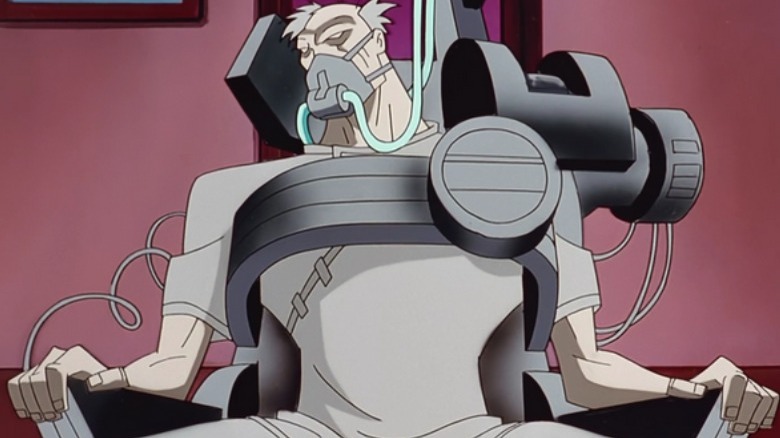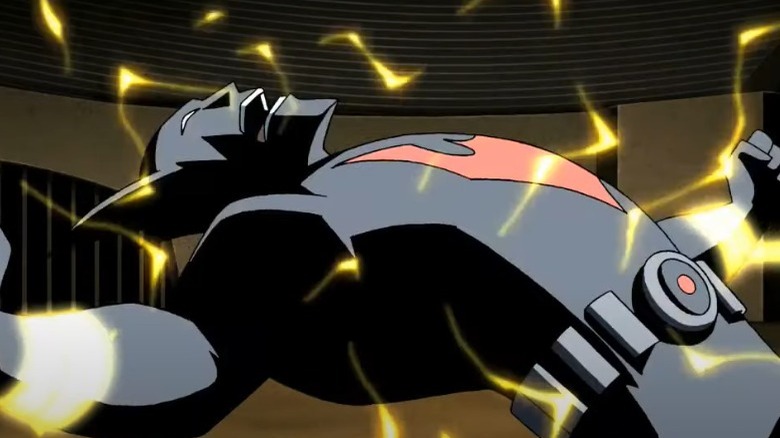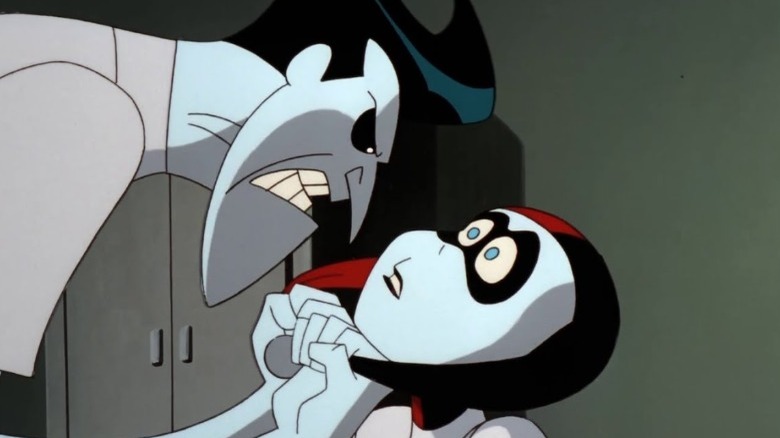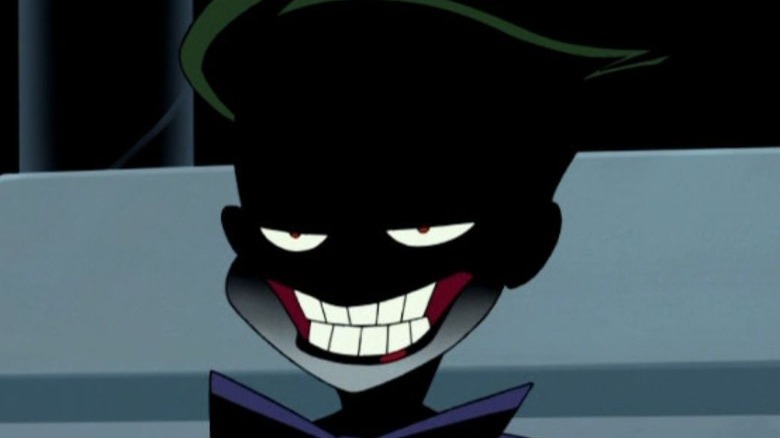Moments From The DC Animated Universe That Went Too Far
Bruce Timm and Paul Dini started something big with the creation of "Batman: The Animated Series" back in 1992. The series would indelibly leave a lasting mark on fandom as one of the most iconic adaptations of the Dark Knight and his coterie of super villains audiences have ever witnessed. The show even collected a couple of Emmy Awards along the way. Its rich, yet sullen world and style ripped right out of the 1950s, albeit with a modern spin, was the perfect playground for the superhero fantasy. Children of the '90s won't soon forget voice actor Kevin Conroy's Batman either.
"Batman: The Animated Series" led to further tales within a now-sprawling universe, with several connected television shows and animated films. The Man of Steel eventually received his own series in 1996 with "Superman: The Animated Series." Static Shock, Batman Beyond, and the rest of the Justice League would all join the "Animated" universe lineup in the years that followed. Despite the animation factor and the idea that these shows were geared towards a much younger crowd, sometimes the ideas presented were rather heavy and maybe a bit much for young eyes. It's also possible that most of these darker moments flew right over a small child's head. But the adults in the room knew exactly what was going on, and sometimes it's a bit twisted for a children's animated show. Let's take a look at the moments within the DC Animated Universe that maybe went a little too far.
Scarecrow forces Batman to see his dead parents
Batman's world is shrouded in darkness, not simply because he operates at night but because he has to confront some of the most evil and maniacal minds the DC comics universe ever produced. Jonathan Crane, or Scarecrow as he is known in the world of super-villains, is nothing short of a mad scientist. But it's his creation that gives him any sense of notoriety. Scarecrow's fear toxin is capable of collapsing minds from sheer terror. Victims crumble before hallucinated manifestations of their worst fears, leaving Scarecrow to enact his own criminal plots without interference. That, in itself, is a rather dark prospect.
Scarecrow utilizes the toxin on Batman during their first encounter in "The Animated Series." It's hard to imagine Batman, of all heroes, fearing anything. But like all of us, he absolutely does. His worst fear is a manifestation of his father proclaiming that Bruce failed the family and is a disgrace to the Wayne name. In one particular instance, Batman is attempting to pursue Scarecrow on top of the villain's get-away zeppelin and he sees his father once again. This time, however, Thomas Wayne transforms into a demonic skeletal figure while continuing to chant that Bruce is a failure. It's dark imagery that certainly evokes a sense of dread.
Barbara's vision of her death
What can possibly be darker than witnessing your own demise and the catastrophic consequences to the ones closest to you as a result? Barbara Gordon experiences this terrifying and harrowing reality in a vision induced by Scarecrow's fear toxin. (Jonathan Crane really enjoys mentally scarring folks, doesn't he?) The "New Batman Adventures" episode "Over the Edge" begins with Gordon and his entire police force assaulting Batman in the Batcave while Alfred is arrested. One wonders what could possibly lead to such an event. Batman recalls the moment that sent Gordon over the edge: Batgirl was tossed off a building by Scarecrow and plunged to her death right on top of her father Commissioner Gordon's car. In this very moment, Jim Gordon shockingly learns that Batgirl is his daughter as she dies in his arms.
Filled with rage, Gordon embarks on a crusade against Batman. Gordon even arranges for Bane to crush Batman in a brutal fight to death. It's one nightmare that Barbara was ecstatic to "wake up" from. However, it also feels like a real possibility, and the downfall of Gordon and his alliance with Batman is a horrifying prospect that viewers won't soon forget.
Grant Walker's eternal imprisonment by Mr. Freeze
Mr. Freeze became a much more well-known fixture of Batman's rogues gallery after his backstory received an overhaul with a new, heartbreaking tale in the animated series. After obtaining his ability to withstand extreme cold temperatures and creating a suit and villainous persona to accompany his condition, a wealthy aristocrat by the name of Grant Walker seeks to replicate Mr. Freeze's transformation to take advantage of the villain's apparently ageless immortality in the "Animated Series" segment, "Deep Freeze."
Walker captures Mr. Freeze and places the fate of Freeze's beloved cryogenically frozen wife at the mercy of Freeze's willingness to comply with Grant and aid his cause. Of course, Mr. Freeze only cares about one thing in this world –- his wife, Nora. So Mr. Freeze helps Walker recreate the incident, giving Walker the same immortality.
Walker plans to freeze the entire world in order to create his own utopia, but Mr. Freeze couldn't care less as he attempts to leave with his wife. Batman, however, convinces Freeze to take action, using Nora as a source of motivation and stating that she'd resent him over his complicity in the act. The tortured villain then freezes the facility, plunging it underwater. He also freezes Grant inside his own cryosuit. The closing moments of the show depict a frozen Grant descending to the bottom of the ocean, screaming inside his icy tomb and cursed to live in eternal torment. It's a grim fate worse than death.
Darkseid's execution of Officer Dan Turpin
Thanks to "Zack Snyder's Justice League," much of the world outside of comic book fandom now know who Darkseid is –- a despotic conqueror and sworn enemy of the Justice League. Throughout Superman's history, the Man of Steel has crossed paths often with the evil Apokalyptian ruler, who tends to unleash his ravenous parademons on the worlds he conquers. In the "Superman: The Animated Series" episode "Apokolips ... Now!" Darkseid and Superman come to blows and — after Kal-El foils much of Darkseid's invasion — the tyrant finds himself agreeing to leave Earth.
A loud-mouthed police officer close to Superman by the name of Dan Turpin is on the scene and he berates the villain as he departs. Before Darkseid leaves, he turns to warn Superman to not enjoy his victory too long. He then uses his Omega beams to kill Dan Turpin right where he stands. Horrified, Superman races after Darkseid, but it's too late. He's gone. It seems the cruel villain couldn't leave without getting one last dig at his rival — with a cold-blooded killing that's an unexpected and shocking moment to say the least.
Salvatore Valestra's creepy demise
"Batman: The Animated Series" took to the big screen with the theatrical release of "Batman: Mask of the Phantasm," in which a mysterious Grim Reaper-like figure gains Batman's attention after a string of murders in Gotham. Only these aren't ordinary killings. The targets are mob leaders or their affiliates. Of course, no new murderous villain enters Gotham without Joker's interest. Realizing the Phantasm's next target, Joker does the job for the shadowy villain.
When the Phantasm enters the home of Salvatore Valestra, the villain heads into the living area to find the illustrious mobster reading the newspaper — or so it appears. After condemning the man to death, the Phantasm pulls the newspaper away to see that Salvatore Valestra is already a corpse, complete with a wild-eyed grin across his cold, dead face. The Clown Prince of Crime has a penchant for killing his victims with a toxin or nerve gas that seemingly causes his prey to smile wide while dying. It's rather macabre and perhaps a jarringly creepy sight for a young viewer, especially when accompanied by a jarring musical cue that definitely echoes similar moments in horror films. It's also a scene that could only be shown in a theatrical film at the time, given strict rules around violence and disturbing imagery in children's daytime cartoons.
Brainiac emerges from Lex Luthor's body
Lex Luthor's penchant for getting involved with other super-villains often backfires. The megalomaniac can be a glutton for punishment but usually has everything all figured out ahead of time since he's supposedly the smartest man around. However, in "Justice League Unlimited" we learn that Lex's previous encounter with Brainiac in the "Superman" series resulted in Luthor being implanted with the alien. It was only a matter of time before Brainiac decided to emerge.
The sequence in which Brainiac shows himself to the Justice League is rather disturbing, as Luthor's body is disfigured by emerging tentacles and a Brainiac face in his abdomen. The Flash says it best: "Dude, that is messed up." Of course, being a children's show, there is an obvious absence of blood and flesh from the transformation despite metallic pieces ripping through Luthor's skin. Regardless, that is one foreign body that will be remarkably difficult to remove. Without any questions, Amanda Waller whips out her gun and puts four bullets in the Luthor/Brainiac monstrosity — just to add a little gun violence to this already disturbing scene.
Clayface consumes a little girl named Annie
Annie, are you okay? Well, Clayface isn't exactly a smooth criminal, but let's just say that Annie is not okay. Michael Jackson references aside, the "New Batman Adventures" episode "Growing Pains" is about a young girl who has seemingly lost her memory and is running from a creepy stalker. Robin helps defend her and whisks her away from trouble on multiple occasions. They agree on the name Annie since she has no recollection of her identity. At first, the episode frames the portrait of a young girl who is fleeing her abusive father –- a rather dark subject on its own.
However, Annie begins to remember certain aspects of her existence, and in the episode's climax, it's revealed that she is a part of Clayface. The man pursuing her is indeed her "father." She was separated from him in order to survey the landscape after Clayface's previous demise and ensure it was safe to emerge. She simply never returned and apparently became sentient all on her own. Robin still refuses to let Clayface take her, but when the malleable villain begins attacking Robin, she attempts to save the Boy Wonder by sacrificing herself. In a horrific scene, Clayface consumes the sentient little girl and she is reabsorbed into his body. The moment provokes Robin to try and kill Clayface, but Batman stops him. It's rather morbid territory to say the least.
A sentient Batman robot learns he isn't really Batman
It's an existential question often pondered by some of the greatest minds in science fiction. What exactly constitutes life and consciousness? If "Blade Runner" is any indication, an A.I. capable of learning and feeling, not simply replicating, human emotions might fit the bill. In the "Batman: The Animated Series" episode "His Silicon Soul," we follow a Batman who's thoroughly convinced he's the real deal when in reality he is a robotic duplicate of the Dark Knight created by the A.I. known as H.A.R.D.A.C. When he confronts the maker of H.A.R.D.A.C., Karl Rossum, he learns the awful truth, though it's hard for him to accept. The robotic Dark Knight achingly proclaims that he has friends and memories. But Rossum simply reveals that everything he thinks he knows is simply stored data.
The moment underscores the genuine trauma one might feel after learning of a terrifying reality they never knew existed. It's heartbreaking and humanizing all in one package, despite the duplicate's metallic structure. In the end, he sacrifices himself to save others, leaving the real Batman to realize that it might very well be possible that the robot had a soul after all. The sacrifice demonstrates a sense of morality and duty beyond any coding or programming.
Bane's fate as the result of his drug addiction
Bane's power comes from Venom — a destructive drug of literally back-breaking proportions. Venom grants Bane the strength and hulking size he needs to contend with Batman. If the aforementioned hint didn't tip you off, this fearsome villain once took Batman out of commission by breaking his back in the "Knightfall" comic book storyline. Like any drug, once Bane discovers its power and the sensational results, there is no "quitting" cold-turkey. In fact, Bane never wants to quit and he uses Venom until the day it finally breaks him, instead.
In the futuristic setting of "Batman Beyond," many of Batman's old foes have aged and withered while some have left continuing legacies. In the episode "The Winning Edge," Bane falls in the former category as an elderly hospital patient, seemingly too frail to even put on his own clothes. Obviously, he is no longer a threat, and there's likely a not-so-subtle commentary here on the destructive forces of drug addiction, even if this particular drug is fictional.
If you or anyone you know is struggling with addiction issues, help is available. Visit the Substance Abuse and Mental Health Services Administration website or contact SAMHSA's National Helpline at 1-800-662-HELP (4357).
The shocking death of Terry McGinnis
Of course, heroes rarely die in these animated shows. But sometimes, a new timeline is created for such an event. In the "Justice League Unlimited" episode "The Once and Future Thing Part 2: Time, Warped," the Justice League travel through time in pursuit of the villain Chronos. Here they run into Terry McGinnis's futuristic Batman from "Batman Beyond." A number of villains ambush the Justice League including Lord Chronos and the Jokerz gang.
While most of the heroes are kept busy with their own scuffles, Terry battles the Jokerz gang, which consists of Dee-Dee clones. They all encircle and trap Terry, ultimately electrocuting him to death. What's even more impactful is the elderly Bruce Wayne's reaction to the death of his successor. Having lived a life where he witnessed the demise of multiple Robins in his career, one of which was brainwashed by the Joker, the tinge of regret, sadness, and failure really hit home in his defeated demeanor.
Joker's abuse of Harley Quinn
It's no secret that Joker was an abusive partner to Harley Quinn. Even if we are not witnessing a physically abusive moment, almost every second of the day he would spout lines that are emotionally damaging to the core. A mind like the Joker's — which thrives on pain and suffering — simply can't help itself. It's hard to imagine that he ever had any semblance of a loving relationship with Harley to begin with.
Harley recounts her origin story as the Joker's sidekick in the "New Batman Adventures" episode "Mad Love." Throughout the episode, Joker doesn't give his "love" the time of day. He's so focused on coming up with his next big scheme that he constantly shoves Harley to the side.
That doesn't even stop Harley from attempting to land some sexy time with her puddin'. But the Joker has no time for that and literally kicks her out the door. While it may seem like a cartoony move in a show aimed at kids, it's still physical abuse and neglect. It truly is an examination of a toxic relationship under the guise of a superhero cartoon for youngsters. While adults now have fond memories of the show and characters like Harley Quinn, some parents might have thought it was too much back in the '90s.
If you or someone you know is dealing with domestic abuse, you can call the National Domestic Violence Hotline at 1−800−799−7233. You can also find more information, resources, and support at their website.
The Joker tortures and brainwashes Robin
This is perhaps the single darkest narrative in the entire DC Animated Universe. In the movie "Batman Beyond: Return of the Joker," we witness just how far the Joker is willing to go to cause Batman pain and suffering. The answer is that there are no limits. Joker captures Tim Drake, one of the Robins who succeeded the original Boy Wonder, Dick Grayson. Tim, who is likely no older than 11 or 12 years of age, is then subjected by the psychopathic Joker to torture and brainwashing. The Clown Prince of Crime taunts the Dark Knight by sending him footage of these events.
Once the Joker is finished with poor little Tim, he was now a walking, talking mini-Joker. He even dresses up like the Joker, bringing his descent into madness much closer to home. Eventually, Tim suffers a mental breakdown and ultimately kills the Joker. While Tim Drake receives the therapy he needs, Batman never lets him don the Robin suit again due to the trauma both of them endure over the incident. As far as animated films go, this narrative actually pushed "Return of the Joker" to receive a PG-13 rating. Perhaps this one time, the adult moments were rated for a more appropriate audience– but were still sure to leave a lasting impact on viewers.
